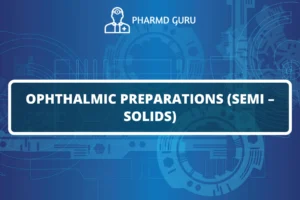Liquid orals, including suspensions, emulsions, and solutions, offer convenient and effective ways to administer medications. These dosage forms are particularly useful for patients who have difficulty swallowing tablets or capsules. In this article, we will explore the formulation and evaluation of suspensions, emulsions, and solutions, as well as discuss the importance of stability in these preparations.
SCROLL DOWN TO THE BOTTOM OF THIS PAGE FOR ACTUAL NOTES.
Table of Contents
- Introduction
- Suspensions
- 2.1 Formulation of Suspensions
- 2.2 Evaluation of Suspensions
- 2.3 Stability of Suspensions
- Emulsions
- 3.1 Formulation of Emulsions
- 3.2 Evaluation of Emulsions
- 3.3 Stability of Emulsions
- Solutions
- 4.1 Formulation of Solutions
- 4.2 Evaluation of Solutions
- 4.3 Stability of Solutions
1. Introduction
Liquid oral formulations, also known as liquid orals, provide a convenient and palatable way to administer medications. They are suitable for patients who have difficulty swallowing solid dosage forms. Suspensions, emulsions, and solutions are three common types of liquid oral formulations.
2. Suspensions
2.1 Formulation of Suspensions
Suspensions consist of solid particles dispersed in a liquid medium. The formulation of suspensions involves the following steps:
- Selection of Active Pharmaceutical Ingredient (API): The choice of API depends on the therapeutic need and desired dosage strength.
- Particle Size Reduction: The API is typically reduced to a smaller particle size to enhance its dispersibility and stability in the suspension.
- Selection of Vehicle: The liquid medium or vehicle, which can be water, syrup, or a combination of both, is chosen based on the API characteristics and patient acceptability.
- Selection of Stabilizers: Stabilizers, such as suspending agents or viscosity-enhancing agents, are added to prevent particle settling and maintain uniform suspension throughout the shelf life.
- Flavoring and Sweetening Agents: Flavoring and sweetening agents may be added to enhance the taste and palatability of the suspension.
2.2 Evaluation of Suspensions
Suspensions undergo various evaluation tests to ensure their quality and performance. Some common evaluation tests for suspensions include:
- Sedimentation Volume: The sedimentation volume test measures the rate at which the solid particles settle in the suspension over time. It assesses the stability of the formulation.
- Redispersibility: Redispersibility testing evaluates the ability of the suspended particles to redisperse uniformly after shaking the suspension.
- Particle Size Distribution: Particle size analysis determines the particle size distribution in the suspension, which impacts the physical stability and efficacy of the formulation.
- Rheological Evaluation: Rheological tests assess the flow and viscosity characteristics of the suspension, which can affect its pourability and ease of administration.
2.3 Stability of Suspensions
Stability is a critical aspect of suspensions to ensure that the solid particles remain uniformly dispersed throughout the shelf life. Factors such as particle size, formulation, pH, temperature, and storage conditions can impact the stability of suspensions. Adequate packaging, protection from light, and proper storage temperature play crucial roles in maintaining the stability of suspensions.
3. Emulsions
3.1 Formulation of Emulsions
Emulsions are biphasic systems in which immiscible liquids are dispersed in each other. The formulation of emulsions involves the following steps:
- Selection of Active Pharmaceutical Ingredient (API): The API selection is based on the therapeutic need and compatibility with the chosen emulsifying agents.
- Selection of Oil Phase: The oil phase, consisting of oils or fats, is selected based on the API solubility and desired release characteristics.
- Selection of Aqueous Phase: The aqueous phase, usually water or an aqueous solution, is chosen based on the API solubility and desired formulation properties.
- Emulsifying Agents: Emulsifying agents, such as surfactants or emulsion stabilizers, are added to promote the formation and stability of the emulsion.
- Flavoring and Sweetening Agents: Similar to suspensions, flavoring and sweetening agents may be added to improve the taste and overall palatability of the emulsion.
3.2 Evaluation of Emulsions
Emulsions undergo evaluation tests to ensure their quality and stability. Some common evaluation tests for emulsions include:
- Creaming or Phase Separation: Creaming or phase separation testing determines the extent to which the emulsion separates into distinct phases upon standing.
- Droplet Size Analysis: Droplet size analysis measures the size distribution of the dispersed phase in the emulsion, which affects the stability and bioavailability of the API.
- Centrifugation Test: Centrifugation testing evaluates the ability of the emulsion to resist separation under high centrifugal forces.
- Visual Inspection: Visual inspection assesses the appearance and homogeneity of the emulsion, looking for any signs of phase separation, creaming, or instability.
3.3 Stability of Emulsions
The stability of emulsions is crucial to ensure that the dispersed phase remains uniformly distributed throughout the shelf life. Factors such as emulsifying agents, pH, temperature, and storage conditions can impact the stability of emulsions. Protective packaging, avoidance of extreme temperatures, and protection from light are essential for maintaining the stability of emulsions.
4. Solutions
4.1 Formulation of Solutions
Solutions are homogeneous mixtures of one or more API dissolved in a liquid solvent. The formulation of solutions involves the following steps:
- Selection of Active Pharmaceutical Ingredient (API): The API is selected based on the therapeutic need, solubility, and desired dosage strength.
- Solvent Selection: The solvent or vehicle is chosen based on the solubility of the API and patient acceptability. Common solvents include water, alcohol, glycerin, or a mixture of these.
- Flavoring and Sweetening Agents: Flavoring and sweetening agents may be added to enhance the taste and palatability of the solution.
- pH Adjustment: pH adjustment may be necessary to optimize API solubility and stability in the solution.
4.2 Evaluation of Solutions
Solutions undergo evaluation tests to ensure their quality and efficacy. Some common evaluation tests for solutions include:
- Appearance: Solutions are visually inspected for clarity, color, and presence of any particulate matter.
- pH Measurement: The pH of the solution is measured to ensure it falls within the specified range for stability and compatibility with the API.
- Assay: Assay testing quantifies the amount of API in the solution to ensure accurate dosing and consistency.
- Microbial Testing: Solutions undergo microbial testing to ensure they meet the required standards for microbial limits.
4.3 Stability of Solutions
Stability is essential for solutions to maintain the integrity and efficacy of the API over time. Factors such as pH, temperature, light, and container integrity can affect the stability of solutions. Appropriate packaging, storage conditions, and protection from light are necessary to ensure the stability of solutions.
ACTUAL NOTES:




